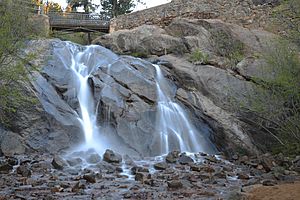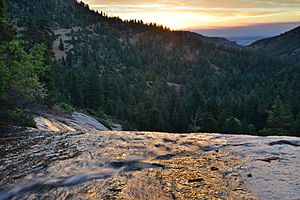Cheyenne Creek facts for kids


Cheyenne Creek is a stream located in Colorado Springs, El Paso County, Colorado. It sits at an elevation of about 5,920 feet (1,804 meters). This creek gets its water from two smaller streams: North Cheyenne Creek and South Cheyenne Creek.
The creek then flows into Fountain Creek near Nevada Avenue, between Interstate 25 and the Pikes Peak Greenway trail. Both North and South Cheyenne Creeks flow through Teller and El Paso Counties. The South Cheyenne Creek starts at Mount Big Chief, close to St. Peter's Dome, and flows down to Seven Falls.
Contents
A Look Back: Cheyenne Creek's History
Early Settlers and Water Rights
Long ago, before European settlers arrived, the Cheyenne people would set up their tepees where Fountain Creek and Cheyenne Creek meet. This was a common stop when they traveled through the area.
Around 1859, a family led by Irving Howbert settled near these creeks. The next year, another settler named John Wolfe also made his home along Cheyenne Creek.
In the 1880s, two people named Willie Wilcox and James Purtales built a dam on part of Cheyenne Creek in Broadmoor. This was on their Broadmoor Dairy property. They created a man-made lake to make the area more attractive for a hotel and casino they were building. The city of Colorado Springs needed more water and tried to take water from the creek. After a legal case, Wilcox and Purtales were confirmed as the rightful owners of the water rights.
Ivywild and Stratton Park
The area known as Ivywild was started in 1888 by William B. Jenkins. It was located along Cheyenne Creek, west of what is now Cascade Avenue and south of the city center.
In 1900, Winfield Scott Stratton, who was the president of the Colorado Springs and Interurban Railway, bought some land. He then gave 20 acres of it to create a park. He named it Cheyenne Park, which later became Stratton Park. This park had bridges, rock walls along Cheyenne Creek, and walking paths. It was a beautiful area with hills, wildflowers, and wildlife, and it was located along the trolley line that went to Cheyenne Canyon. In 1932, a part of the park was sold to a real estate developer. Ten acres were also sold for the construction of the Colorado P.E.O. Sisterhood Chapter House.
How Cheyenne Creek Helps Colorado Springs Get Water
Cheyenne Creek is an important source of water for the city of Colorado Springs. The South Suburban Water Company owned the land and water rights, including North and South Cheyenne Creeks, until 1966. At that time, the city of Colorado Springs bought them.
Water from North and South Cheyenne Creeks flows into reservoirs or continues downstream. North Cheyenne Creek's water goes into Gold Camp and South Suburban reservoirs. South Cheyenne Creek's water flows into the South Suburban Pumping System. From there, it can go into either of the reservoirs or continue downstream. These reservoirs and the pumping station are located near where the north and south streams join to form Cheyenne Creek. Eventually, all this water flows into Fountain Creek. The pumping station can also send water to the Penrose Reservoir, which supplies water for the irrigation system at The Broadmoor.

